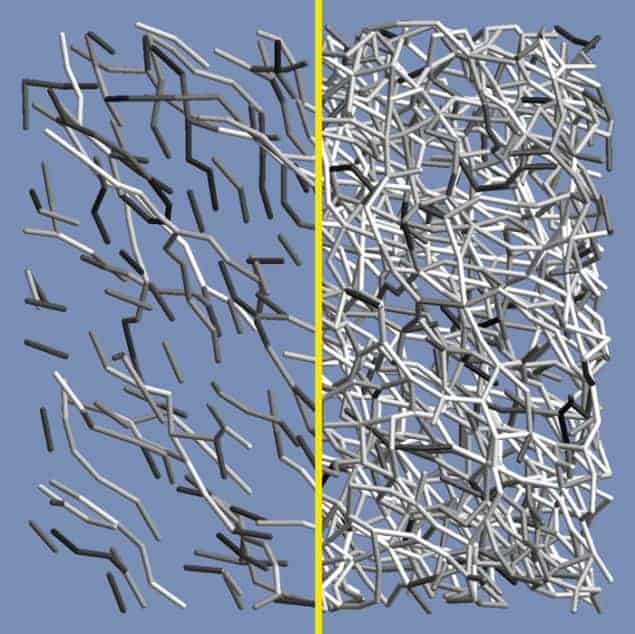
A new model combining fluid dynamics with granular dynamics can provide important insights into discontinuous shear thickening – a curious effect that causes some fluid-like materials to suddenly behave like a solid. Developed by physicists in the US, the model agrees with key experimental observations and could help researchers develop new technologies based on shear thickening, such as flexible body armour.
Suspensions of tiny solid particles dispersed in fluids can exhibit a range of bizarre properties that have proven difficult for physicists to fully understand using traditional fluid dynamics. Most notably, they do not have a constant viscosity: some suspensions become runnier when they are stirred faster or pushed harder, while others become thicker. Albert Einstein first evaluated the effect of suspended particles on viscosity in 1906, and there have been numerous theoretical models since then. None of these, however, has adequately explained discontinuous shear thickening: the abrupt solid-like stiffening that is easily observed in a suspension of corn starch in water.
In the new research, Ryohei Seto and colleagues at the City College of New York considered the essential nature of a suspension – a mixture of solid grains and liquid medium. This allowed them to combine ideas from fluid dynamics with those from granular physics. In fluid dynamics models, suspended particles are forbidden to touch, and all interactions are mediated by the fluid medium. In contrast, there is no medium in granular physics, or the medium is a gas that offers little resistance to particle contact. As a result the macroscopic dynamics of granular physics are the product of individual interactions between the granules.
Chains of force
At low shear, the viscosity is mainly caused by the difficulty the medium has in squeezing itself between the solid particles as the suspension is moved. In reality, there are direct contacts between the particles, and these do add to the viscosity. Forces applied to one particle can sometimes be passed directly to the next, creating a chain of particles moving together. However, these force chains are well dispersed and too short to have a significant impact on the macroscopic behaviour of the suspension.
Above a certain shear rate, however, the direct contacts between particles become more numerous as the particles are forced closer together more and the medium is unable to flow between them fast enough. This creates more chains of particles moving together, and allows the chains to get longer. At a certain point, the chains get tangled up in each other and lock together, and the suspension becomes an amorphous solid with liquid in the gaps between particles.
While this kind of jamming behaviour is well understood in granular physics, the New York researchers’ model is the first to start from the basic forces on a suspended particle and capture this liquid–solid crossover. “Starting from basic assumptions familiar to the hydrodynamics community,” says Seto, “we introduced some particle contact, and we borrowed a model from granular physics to describe contact. So our work is bridging two fields.”
The model does a good job of reproducing a range of experimental results obtained in several different labs. Indeed, Seto explains that the group’s model provides a unified explanation of results that had been interpreted in different ways in the past.
Heinrich Jaeger at the University of Chicago is impressed by the team’s work: “I’m very excited about this paper combining ideas from two perspectives – the granular perspective, which starts from solid on solid and then worries about what happens when you put liquid in, and the suspension rheology perspective that starts from a liquid and wonders what happens when you put particles in.”
Aside from scientific interest, both Seto and Jaeger say that the work has technological applications. “Discontinuous shear thickening is typically thought of as a problem in industries,” says Jaeger. “If you are trying to transport these dense suspensions through pipes and they suddenly lock up this would be a potential disaster. Therefore it is very important to have a good approach to controlling this behaviour.” He adds that there are also applications in which it is desirable, such as flexible stab vests or other protective clothing. “At slow agitation the material behaves rather liquid-like, while sudden impacts can activate this shear thickening, which immediately turns the material into a more solid-like form.”
The research is published in Physical Review Letters.



